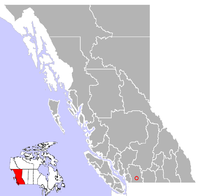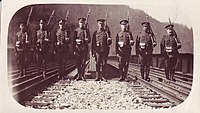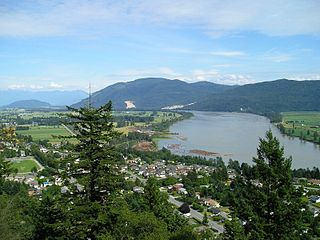
The Fraser River is the longest river within British Columbia, Canada, rising at Fraser Pass near Blackrock Mountain in the Rocky Mountains and flowing for 1,375 kilometres (854 mi), into the Strait of Georgia just south of the City of Vancouver. The river's annual discharge at its mouth is 112 cubic kilometres (27 cu mi) or 3,550 cubic metres per second (125,000 cu ft/s), and each year it discharges about 20 million tons of sediment into the ocean.
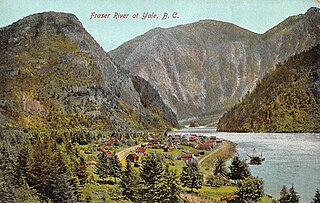
Yale is an unincorporated town in the Canadian province of British Columbia, which grew in importance during the Fraser Canyon Gold Rush.

The Stó꞉lō, alternately written as Sto꞉lo, Stó꞉lô, or Stó꞉lõ, historically as Staulo, Stalo or Stahlo, and historically known and commonly referred to in ethnographic literature as the Fraser River Indians or Lower Fraser Salish, are a group of First Nations peoples inhabiting the Fraser Valley and lower Fraser Canyon of British Columbia, Canada, part of the loose grouping of Coast Salish nations. Stó꞉lō is the Halqemeylem word for "river", so the Stó꞉lō are the river people. The first documented reference to these people as "the Stó꞉lō" occurs in Catholic Oblate missionary records from the 1880s. Prior to this, references were primarily to individual tribal groups such as Matsqui, Ts’elxweyeqw, or Sumas.
The Chehalis River is located in the southwest corner of British Columbia, Canada near the city of Chilliwack. It flows south-eastward out of the Douglas Ranges of the Coast Mountains, draining into the Harrison River.

Harrison Hot Springs is a village located at the southern end of Harrison Lake in the Fraser Valley of British Columbia, Canada. It is a part of the Fraser Valley Regional District; its immediate neighbour is the District of Kent, which includes the town of Agassiz. As its name would suggest, it is a resort community known for its hot springs and has a population of just over 1,500 people. It is named after Benjamin Harrison, a former deputy governor of the Hudson's Bay Company.
Ruskin is a rural, naturally-treed community, about 35 mi (56 km) east of Vancouver on the north shore of the Fraser River. It was named around 1900 after of the English art critic, essayist, and prominent social thinker John Ruskin.
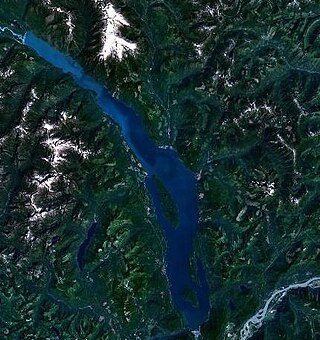
Harrison Lake is the largest lake in the southern Coast Mountains of Canada, being about 250 square kilometres (95 mi²) in area. It is about 60 km (37 mi) in length and at its widest almost 9 km (5.6 mi) across. Its southern end, at the resort community of Harrison Hot Springs, is c. 95 km east of downtown Vancouver. East of the lake are the Lillooet Ranges while to the west are the Douglas Ranges. The lake is the last of a series of large north-south glacial valleys tributary to the Fraser along its north bank east of Vancouver, British Columbia. The others to the west are the Chehalis, Stave, Alouette, Pitt, and Coquitlam Rivers. Harrison Lake is a natural lake, not man-made. The lake is supplied primarily from the Lillooet River, which flows into the lake at the northernmost point.
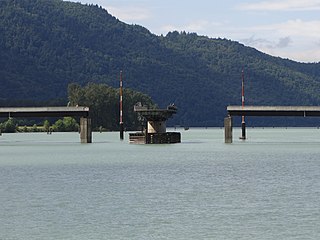
The Harrison River is a short but large tributary of the Fraser River, entering it near the community of Chehalis, British Columbia, Canada. The Harrison drains Harrison Lake and is the de facto continuation of the Lillooet River, which feeds the lake.

The Douglas Ranges are a subrange of the Pacific Ranges of the Coast Mountains of the Canadian province of British Columbia, about 70 km (43 mi) east of downtown Vancouver, north of the Fraser River and between the valleys of Stave and Harrison Lakes. They are approximately 4,900 km2 (1,900 sq mi) in area. Their highest peak is Mount Robertson 2,252 m (7,388 ft), at the northwest limit of the range.
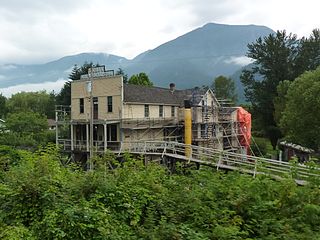
Kilby Provincial Park is a provincial park in British Columbia, Canada. Kilby Park is located in Harrison Mills, on the Harrison River overlooking Harrison Bay in the Upper Fraser Valley of southwestern British Columbia. It comprises 3 hectares with 30 campsites and a boat launch. The park offers a sandy summer beach and fall/winter viewing of bald eagles and migrating trumpeter swans from Alaska.

The District of Kent is a district municipality located 116 kilometres (72 mi) east of Vancouver, British Columbia. Part of the Fraser Valley Regional District, Kent consists of several communities, the largest and most well-known being Agassiz—the only town in the municipality—Harrison Mills, Kilby, Mount Woodside, Kent Prairie, Sea Bird Island and Ruby Creek. Included within the municipality's boundaries are several separately-governed Indian reserves, including the Seabird Island First Nation's reserves on and around the island of the same name.
The Giscome Portage was a portage between the Fraser River and Summit Lake, which connected with the river route to the Peace Country via Finlay Forks. BC Parks administers the Giscome Portage Trail. The Huble Homestead Historic Site, at the south end, is on the Fraser River, 40 kilometres (25 mi) north of Prince George and 6 kilometres (3.7 mi) off Highway 97.
The Sts'ailes, also known as Chehalis are an indigenous people from the Lower Mainland region of British Columbia, Canada.

Steamboats operated on Grays Harbor, a large coastal bay in the State of Washington, and on the Chehalis and Hoquiam rivers which flow into Grays Harbor near Aberdeen, a town on the eastern shore of the bay.
Giscome is a community comprising scattered houses located at the southwest end of Eaglet Lake, which is east of Willow River, in central British Columbia. A combined elementary school and East Line Activity Centre serves the surrounding settlements from Willow River to Longworth. In 2020, Graymont Western Canada Inc. is planning to open a quarry and lime plant on the former mill and Canadian National Railway (CNR) quarry sites. The community and Giscome Portage were named after John Robert Giscom(b)e, a black prospector from Jamaica, who came to the district in the 1860s.
Lake Errock is an unincorporated community in the Fraser Valley region of southwestern British Columbia. Housing exists primarily on the northwestern shore of the same named lake, which lies southwest of Harrison Bay. The locality, on BC Highway 7, is by road about 23 kilometres (14 mi) west of Agassiz, 95 kilometres (59 mi) east of Vancouver, and 28 kilometres (17 mi) east of Mission.

Andersonia is an unincorporated community in Mendocino County, California. It is located near U.S. Route 101 on the South Fork of the Eel River 1 mile (1.6 km) north-northwest of Piercy, at an elevation of 541 feet.
Harrison Hill (622m) is a small mountain located at the confluence of the Harrison and Fraser Rivers in the Lower Mainland region of British Columbia, Canada. Harrison Knob (~225m) is a prominent shoulder to the east of the main peak of Harrison Hill. Harrison Hill and Harrison Knob are on the north side of the Fraser opposite Chilliwack, Harrison Knob overlooks the confluence directly, Harrison Hill itself separates the Fraser downstream from that confluence and overlooks on its north Harrison Bay, a large, shallow lake-like sidewater of the Harrison River, while at its western foot is the community of Lake Errock. At its eastern foot, just below Harrison Knob, had been the formerly large sawmill town of Harrison Mills, which spanned both sides of the Harrison and was served by the mainline of the Canadian Pacific Railway, which runs along the north side of the mountain's base. The Indian Reserves of the Scowlitz First Nation are at the western end of Harrison Bay and at its outlet at its eastern end, while the reserve of the Chehalis First Nation is along its north shore, and Kilby is on its east shore.
Harrison Bay is a lake-like expansion of the Harrison River, located west of its main course adjacent to the communities of Chehalis and Harrison Mills in the Canadian province of British Columbia. Extremely shallow, the bay outlets to the Fraser at Harrison Mills, where in pre-gold rush times there had been a "riffle", which was dredged to enable easier steamer traffic to Harrison Lake and Port Douglas. The bay has been used as a log sort but is primarily recreational in use today, with the Scowlitz Indian Band running a beach and campground at its western end, on Squawkum Creek Indian Reserve No. 3, which is at the southwest corner of Harrison Bay. Between it and the Fraser lies Harrison Hill, known in Upriver Halkomelem as Qithyll, which is an ancient burial ground currently under investigation by the First Nation in a joint effort with Simon Fraser University's archaeology department.. Adjacent to Kilby Provincial Park and the site of Harrison Mills are Williams Indian Reserve No. 2 and Scowlitz Indian Reserve No. 1

The Beaver Mills Lumber Company was a sawmill established in 1895 on the Rainy River in Northwestern Ontario, near the international border with Baudette, Minnesota. In 1910, as the Rat Portage Lumber Company, it was destroyed in the Baudette Fire.

